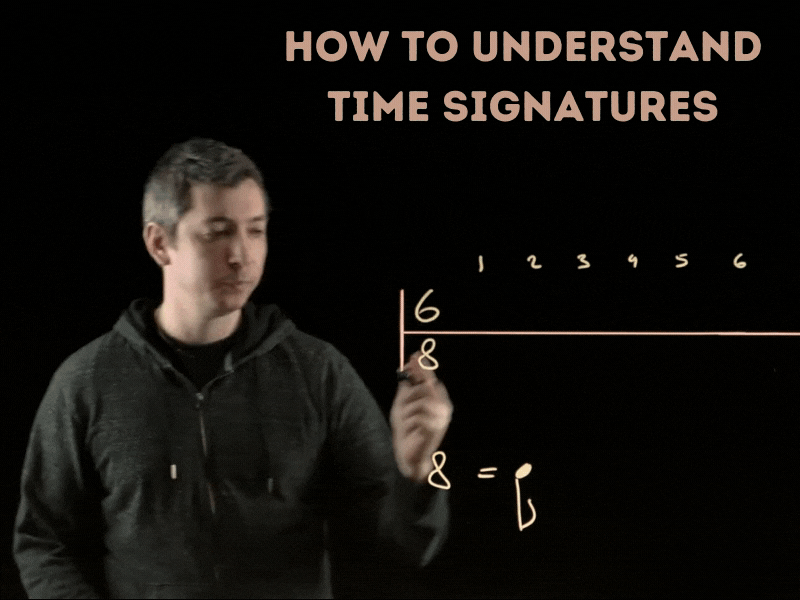To the untrained eye, sheet music can look a little intimidating.
If you're not familiar with reading music you're probably wondering what exactly a time signature is. What are those fractions even supposed to mean?
Don't worry! We have the answers and explain everything you need to know about the music theory basics surrounding time signatures.
But first, let's introduce today's video host.
Vitali Tkachenka
Vitali Tkachenka is the Director of E-Learning and an Instructor for the Atlanta Institute of Music and Media.
Vitali is the author of 'Modern Scales Concepts,' 'Diatonic Modes Concepts,' 'Killer Technique: Guitar', and 'Technique Workout for the Modern Guitarist.'
Today he's going to teach you how easy it can be to read time signatures.
Check out the videos below, along with the supplemental highlight transcriptions so you can conquer time signatures.
Table of Contents:
- The Top Number of a Time Signature
- The Bottom Number
- What if the Bottom Number is 4?
- What if the Bottom Number is 8?
- What if the Bottom Number is 16?
- Wrapping it Up
The Top Number of a Time Signature
Let's finally reveal what those fractions mean. Time signatures are represented by two numbers written on a staff.
The number at the top can be almost any number you can think of. For the purposes of this example, we'll utilize the number two. This top number tells us how many beats we have in the measure. Therefore, the top number defines the length of the measure.
In our example, to complete one measure of our notation, we need to have two clicks of a metronome.
However, the top number can never be the number one, because the measure would only be one single click of the metronome. So, keep in mind that two is the lowest number the top number of a time signature can be.
In traditional music, the top number is never greater than 16, but in modern notation, it can go up to 32.
The Importance of the Bottom Number
Unfortunately, some people may ignore the bottom number of the time signature after gathering how many beats are in a measure.
This is a major mistake as the bottom number is incredibly important.
The bottom number gives you an idea of how to count the notation of a particular time signature.
Let's say we have the number two at the bottom. That tells you that every click of your metronome will be equal to a half note in that particular measure.
And right now, we have two beats in the time signature that will be equal to a single half note.
It's vital to understand that every note value defined by your time signature's bottom number will always be counted as a number (rather than an "and,") because it will always be played with a click of your metronome.
If you want to write quarter notes in the measure, quarter notes will be counted as a part of a beat.
Therefore, in our current 2/2 time signature (also known as cut time), two quarter notes will fit in the click of a metronome.
What if the Bottom Number is 4?
The next number we will discuss being at the bottom of the time signature is the number four.
For simplicity, and similar to the video above, we will use both a four on top and a four on the bottom of the time signature.
What does this four on the bottom tell us? The bottom number four now dictates that every click of your metronome will be equal to a single quarter note.
What if we decide to fill out the measure with more notes? There are notes that are twice as short as quarter notes that are called eighth notes.
In our 4/4 measure example, we can put an eighth note between every quarter note to speed it up.
However, not every note will be played with a metronome click. These notes will be played on a count in between the metronome clicks that's called an "and" and written with a "+" designation.
To count the measure we would say," one 'and' two 'and' three 'and', etc." If you have notes that are longer than quarter notes, those notes will occupy several clicks of your metronome.
What if the Bottom Number is 8?
Now let's discuss an example where every beat of our metronome will be equal to an eighth note.
In this case, we'll make our top number a six, which means we have six beats (or six clicks of our metronome) per measure.
Our bottom number will be an eight, so every click of our metronome will equal a single eighth note.
If there are notes longer than eighth notes in this measure, like quarter notes or half notes, they will be counted as multiple clicks of our metronome. However, whole notes will not fit in this time signature because there's not enough space for it.
To simplify our counting, we can organize our eighth notes in groups of three. Visually it looks much more symmetrical, and it simplifies the counting process.
Be sure to check out the video above to better grasp how it simplifies the counting process and why it is different than a triplet.
What if the Bottom Number is 16?
And finally, what if the bottom number of the time signature is 16?
Like the example in the video, let's use the number four for our top number, which means we'll have four beats in this measure.
When we have 16 at the bottom, it means that every click of your metronome is equal to one 16th note, which is a pretty short note.
So now we have four beats, and every beat is equal to a 16th note.
16th notes can be pretty complex to look at and track. Unfortunately, you are pretty limited with how you can organize these notes.
The best way to go about organizing the notes is to put them into groups of two.
Don't forget that every 16th note is not counted as a certain instance of your beat, but it is actually equal to a single beat or click of your metronome. The beats in-between the 16th notes would be counted as 32nd and 64th notes, but we won't get into those very fast notes today.
Wrapping It Up
As you can see, the bottom number in a time signature is critical because it determines which type of note you count as a number or a click on your metronome.
At the bottom, you can have the numbers two, four, eight, and sixteen.
The top number can be any number from two to 32 in modern music and 2 to 16 in traditional music.
You should always pay attention to both numbers, not just the top number that determines the number of beats, but also the bottom number, so you know how to count properly.
Combining both parts of the time signature is the only way to correctly read music and know you are performing the correct way.
Learn More With Vitali
With just a little practice, you will be able to quickly grasp the basics of time signatures. When learning music, there is no substitution for practice.
Why not practice with Vitali Tkachenka at the Atlanta Institute of Music and Media?
The Atlanta Institute of Music and Media offers several degree programs for musicians and producers. These include the following:
- Music Production and Audio for Media Associate Degree
- Music and Technology Associate Degree: Concentration in Guitar, Voice, Bass, Drums, or Keyboard
- Online Certificate in Music and Technology: Guitar or Bass Concentration
- Certificate in Music Production
- Performance Certificate: Focus in Guitar, Voice, Bass, Drums, or Keyboard
Note: During this anxious and challenging time we currently live in, AIMM is proud to let students completely control their learning experience by choosing courses online, on-campus, or hybrid.
We know choosing the right music school is a big deal, so why not get a taste first? Click the button below to check out AIMM's Free Online Course! Discover how AIMM can benefit your music career today.
Start a Free Online Intro Course










